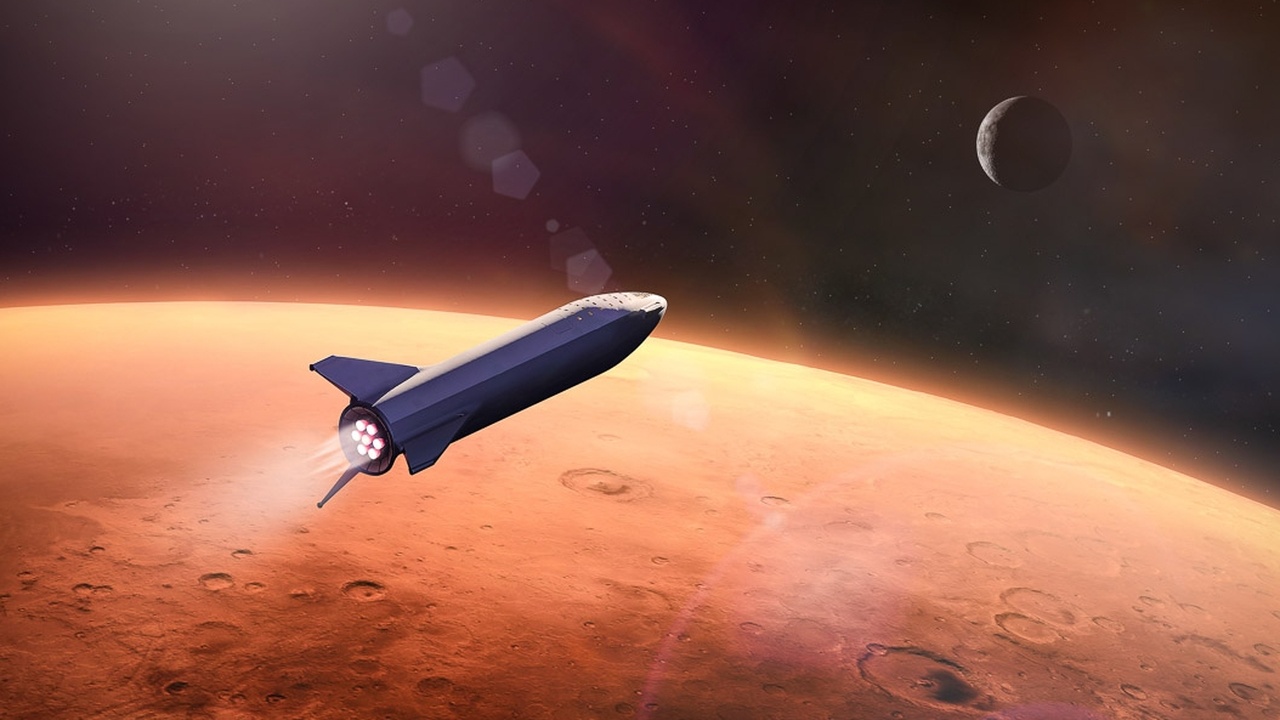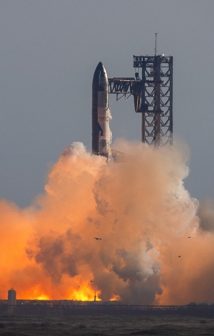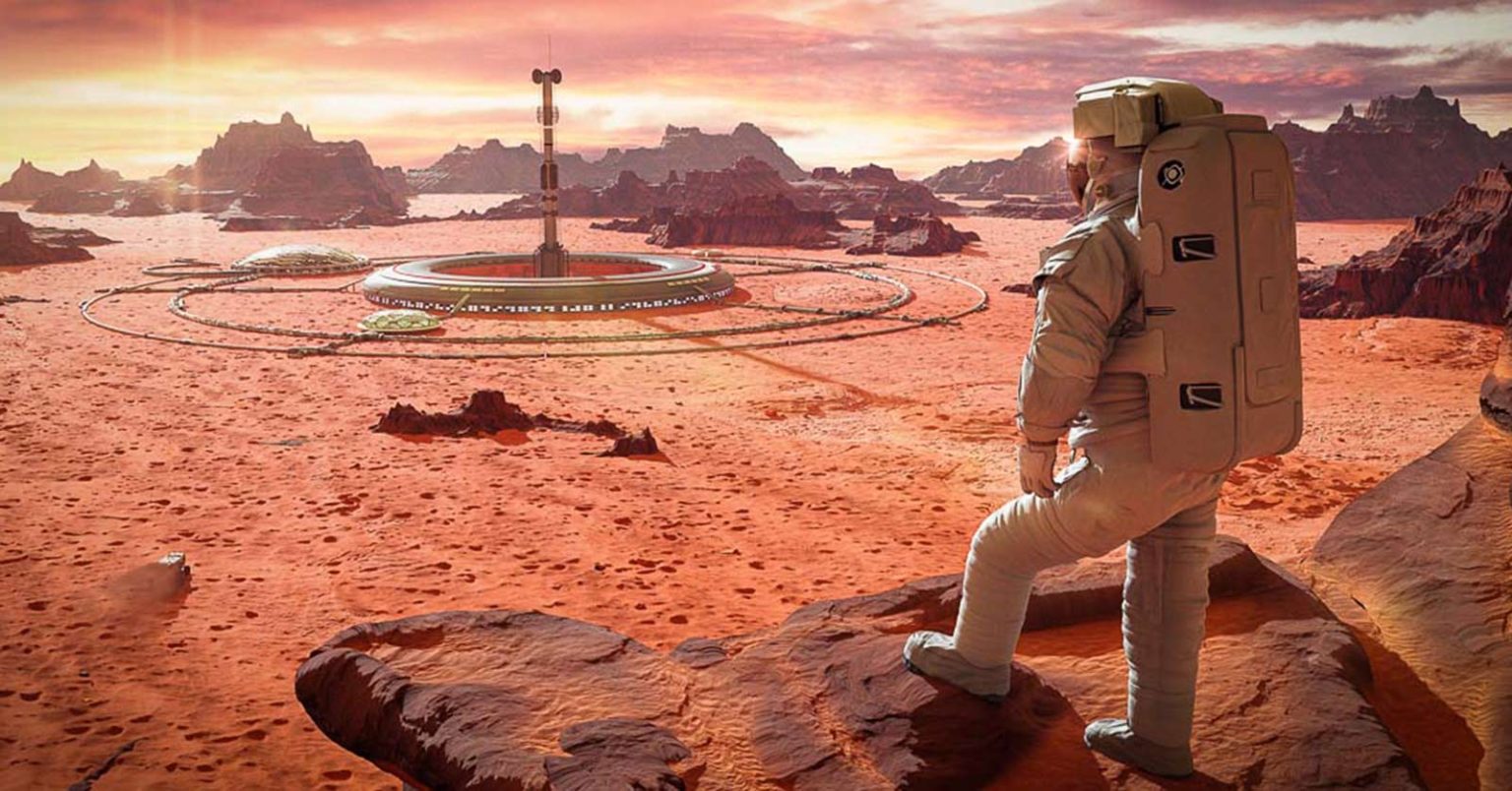SpaceX has explicitly set the exploration and colonization of the Red Planet as a corporate goal. Is this just the crazy idea of a billionaire nerd, or is there more to it? An excerpt from our first US Edition «Super!!! How Elon Musk Fights Tyranny in Europe».
Astronaut Nick Adam is part of the crew of a space station on Mars. One day he awakens without any memory of what happened before. Nick is injured, and in the colony’s plant lab lies the body of a biologist. The murderer must have been someone from their team, the mission participants believe – but no one knows what happened in the last few hours. A race against time begins as it quickly becomes clear that even before humans landed, other life forms were moving in the inhospitable crater landscapes…
The Red Planet has always fueled the imagination of science-fiction authors. German up-and-coming author Robert Rittermann, who tells the story of Adam and his crew in his 2024 duology The Mars Paradox, could not escape this fascination.

The most prominent example, however, is the American master writer Philip K. Dick, who not only provided the literary basis for Ridley Scott’s legendary movie Blade Runner (1982) but also the material for Paul Verhoeven’s sci-fi thriller Total Recall (1990) starring Arnold Schwarzenegger as construction worker Douglas Quaid. Initially, Quaid implants a computer-generated memory of a vacation on Mars, but later he actually ends up at his dream destination because he has to flee from his pursuers.
At the turn of the millennium, two Hollywood blockbusters about the planet named after the Roman god of war, Mission to Mars and Red Planet, were released. The latter is set in 2025: Earth is struggling with environmental issues. Therefore, Mars is to be colonized as Planet B, for which algae are released to produce oxygen through solar radiation. Indeed, the oxygen levels initially rise but then suddenly drop rapidly. A group of scientists, led by pilot and commander Kate Bowman (Carrie-Anne Moss), embarks on a spaceship to investigate the phenomenon.
More Than Science-Fiction
The screenplay for the exciting film was written by Chuck Pfarrer, but it could as well have been penned by Elon Musk, as he also plans a mission to Mars with SpaceX to make the planet a potential refuge for humanity. It doesn’t even need to be an ecological catastrophe that forces Homo sapiens to become an «interplanetary species,» Musk said in his talk with AfD leader Alice Weidel. The threat of nuclear war or the possibility of a large meteorite impact should also give one pause.
In the magazine New Space, he explained his motive back in 2017:
«History will come to a fork. One path is that we stay on Earth forever – and eventually, an event leads to extinction. I have no specific prophecy for the apocalypse, but eventually, as history suggests, such an event will occur. The alternative is to become a spacefaring civilization and multiplanetary species, and I hope you agree that this is the right path.»
The self-proclaimed science-fiction fan hasn’t just been interested in space since yesterday. Back in the early 1980s, the tech enthusiast born in Pretoria in 1971 published the program code for a video game he developed at age 12 called Blastar in a South African tech journal, describing it with the following words: «In this game, you must destroy an alien space transporter carrying deadly hydrogen bombs and state-changing machines.» At the same time, Musk was deeply engaged with German philosophy, especially Schopenhauer, Heidegger, and Nietzsche. (…)

Starship Trooper
Many years ago Musk joined an association called The Mars Society, which also had NASA scientist Carol Stoker and star director James Cameron as members. «The goal of the society was the exploration and colonization of the Red Planet,» explains journalist Ashlee Vance in his book Elon Musk: Tesla, SpaceX, and the Quest for a Fantastic Future. At the gala dinners of this exclusive club, the tech entrepreneur entertained other guests «with stories about a research station installed by the society in the Arctic to simulate the harsh living conditions on Mars.»
In this milieu, Musk’s ideas for the so-called Mars Oasis also matured. «According to this plan, Musk would buy a rocket and send it to Mars with a kind of robot greenhouse. A group of scientists had already worked on a space-capable growth chamber for plants. The idea was to modify it so it could take in Martian soil and grow plants on it, thus creating the first oxygen on Mars. To Musk’s delight, this plan seemed both spectacular and feasible,» writes Vance in his Musk biography (German edition).
The entrepreneur «wanted the chamber to have a window and send videos back to Earth so people could watch the plants grow.» NASA manager Dave Bearden, who took part at one meeting, is quoted by Vance saying: «It was about being able to say: ”Yes, there is life on Mars, and we brought it there.” The hope was to show thousands of young people that this place isn’t so hostile. Then they might start thinking about going there themselves.»
Today, SpaceX has the Starship, a heavy rocket that could be used for a Mars mission. The impressive machine consists of a lower booster section and an upper stage, also called Starship, which serves as the spacecraft. Both stages are powered by Raptor engines. The unique feature of the rocket: it doesn’t end up as space junk but returns almost completely to Earth, making it reusable and thus very cost-effective. The launch system can carry up to 150 tons of payload and is intended to eventually replace all other SpaceX rockets: the Falcon 9 and Falcon Heavy rockets as well as the Dragon 2 spacecraft. (…)
Fire at Will!
Indeed, no planet seems more predestined for the first extraterrestrial colony than Mars. On average, it is «only» 292 million miles away from us, making it the nearest Earth-like celestial body. Musk wants to cover this distance in 80 days. The surface of the fourth planet in our solar system is roughly the same size as Earth’s, although the atmosphere is thin, it offers protection from cosmic radiation.
A year there lasts almost twice as long as on Earth, but a Sol – a day on Mars – is 24 hours, 39 minutes, and 35 seconds long. Moreover, researchers now know there is water on Mars. However, it’s clear that life on that planet wouldn’t be comfortable as long as one couldn’t move outside without protective suits and helmets; aside from the Arctic temperatures ranging between minus 23 and minus 284 °F. And first you have to find out if human reproduction would even work after the long space journey and under Martian conditions. (…)
Read the whole article in our US Edition «Super!!! How Elon Musk Fights Tyranny in Europe».
 The complete table of contents:
The complete table of contents:
Cover Story
Super: How Elon Musk Fights Tyranny in Europe: Alice follows the white rabbit
Elon Musk Up Close: Interview with influencer Naomi Seibt
«Only AfD can save Germany!» Alice Weidel in conversation with Elon Musk
Musk and Mars: Science-fiction becomes reality
Free Tommy Robinson! Why Elon Musk wants to bring down the UK government
Amore e futurismo: How Musk and Meloni shake up Italy
Politics
The Trail of the Green Devils: All jihad? Don’t forget the Deep State!
Syria’s Fragile Peace: Who wins after Assad’s fall?
48 Minutes to Dictatorship: The failed coup in South Korea
Forced to War by Economics: Debt crisis and de-dollarization
Musk, Milei, and Money: Guys with chainsaws
A Kennedy Strikes Back: Trump’s Health Secretary warms up
Dossier: The German President
King of Kallstadt: Trump’s German roots
Schurz, Strauss, and Studebaker: Germans in America
Life
The Great Cover-Up: Who killed John F. Kennedy?
Aliens Over Nuremberg: UFO battle in the Middle Ages
Back to the Future: Tradwife as a new role model
The Emperor of Kekistan: Musk and the rebels of the crypto scene
Columns
64 Hartlage’s Newspeak _ Disinformation
65 Hampel’s Review _ My American Friends
66 Sellner’s Revolution _ Time of Turncoats
To get the US Edition of COMPACT Magazine «Super!!! How Elon Musk Fights Tyranny in Europe» please click here.





